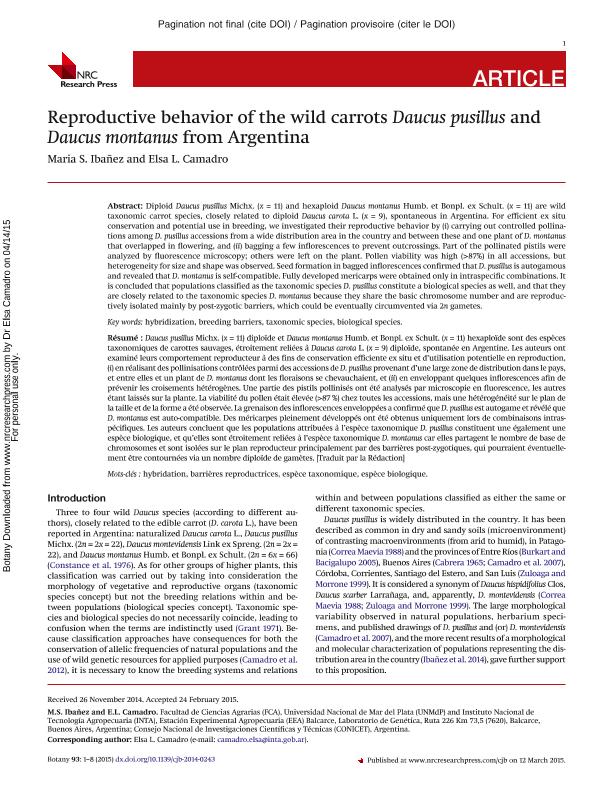Artículo
Diploid Daucus pusillus Michx. (x = 11) and hexaploid Daucus montanus Humb. et Bonpl. ex Schult. (x = 11) are wild taxonomic carrot species, closely related to diploid Daucus carota L. (x = 9), spontaneous in Argentina. For efficient ex situ conservation and potential use in breeding, we investigated their reproductive behavior by (i) carrying out controlled pollinationsamong D. pusillus accessions from a wide distribution area in the country and between these and one plant of D. montanus that overlapped in flowering, and (ii) bagging a few inflorescences to prevent outcrossings. Part of the pollinated pistils were analyzed by fluorescence microscopy; others were left on the plant. Pollen viability was high (>87%) in all accessions, butheterogeneity for size and shape was observed. Seed formation in bagged inflorescences confirmed that D. pusillus is autogamous and revealed that D. montanus is self-compatible. Fully developed mericarps were obtained only in intraspecific combinations. It is concluded that populations classified as the taxonomic species D. pusillus constitute a biological species as well, and that they are closely related to the taxonomic species D. montanus because they share the basic chromosome number and are reproductively isolated mainly by post-zygotic barriers, which could be eventually circumvented via 2n gametes. Daucus pusillus Michx. (x = 11) diploïde et Daucus montanus Humb. et Bonpl. ex Schult. (x = 11) hexaploïde sont des espèces taxonomiques de carottes sauvages, étroitement reliées a` Daucus carota L. (x = 9) diploïde, spontanée en Argentine. Les auteurs ont examiné leurs comportement reproducteur a` des fins de conservation efficiente ex situ et d’utilisation potentielle en reproduction, (i) en réalisant des pollinisations contrôlées parmi des accessions de D. pusillus provenant d’une large zone de distribution dans le pays, et entre elles et un plant de D. montanus dont les floraisons se chevauchaient, et (ii) en enveloppant quelques inflorescences afin de prévenir les croisements hétérogènes. Une partie des pistils pollinisés ont été analysés par microscopie en fluorescence, les autres étant laissés sur la plante. La viabilité du pollen était élevée (>87 %) chez toutes les accessions, mais une hétérogénéité sur le plan de la taille et de la forme a été observée. La grenaison des inflorescences enveloppées a confirmé que D. pusillus est autogame et révélé que D. montanus est auto-compatible. Des méricarpes pleinement développés ont été obtenus uniquement lors de combinaisons intraspécifiques. Les auteurs concluent que les populations attribuées a` l’espèce taxonomique D. pusillus constituent une également une espèce biologique, et qu’elles sont étroitement reliées a` l’espèce taxonomique D. montanus car elles partagent le nombre de base de chromosomes et sont isolées sur le plan reproducteur principalement par des barrières post-zygotiques, qui pourraient éventuellement être contournées via un nombre diploïde de gamètes.
Reproductive behavior of the wild carrots Daucus pusillus and Daucus Montanus from Argentina
Fecha de publicación:
01/2015
Editorial:
National Research Council Canada-NRC Research Press
Revista:
Botany
ISSN:
1916-2790
Idioma:
Inglés
Tipo de recurso:
Artículo publicado
Clasificación temática:
Resumen
Palabras clave:
HYBRIDIZATION
,
BREEDING BARRIERS
,
TAXONOMIC SPECIES
,
BIOLOGICAL SPECIES
Archivos asociados
Licencia
Identificadores
Colecciones
Articulos(CCT - MAR DEL PLATA)
Articulos de CTRO.CIENTIFICO TECNOL.CONICET - MAR DEL PLATA
Articulos de CTRO.CIENTIFICO TECNOL.CONICET - MAR DEL PLATA
Citación
Ibañez, Maria Silvina; Camadro, Elsa Lucila; Reproductive behavior of the wild carrots Daucus pusillus and Daucus Montanus from Argentina; National Research Council Canada-NRC Research Press; Botany; 93; 5; 1-2015; 279-286
Compartir
Altmétricas




